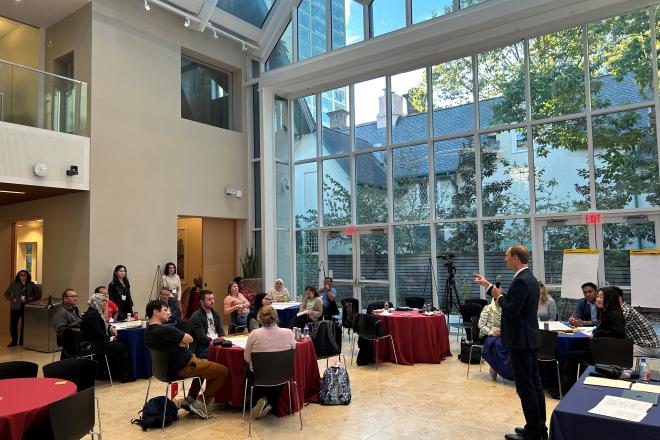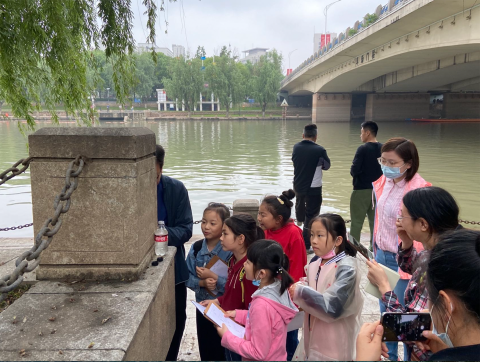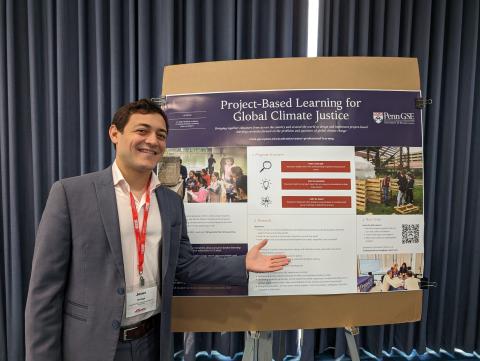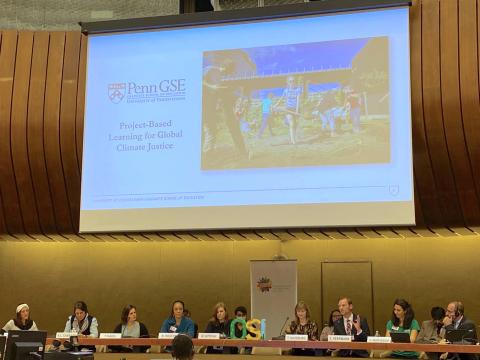From the classroom to the real world
It’s an uncertain time for the planet, and the actions we take to address climate change today will have the largest impact on young people and future generations. So, shouldn't teachers and students be part of devising the solutions?

By Xime Trujillo
It’s an uncertain time for the planet, and the actions we take to address climate change today will have the largest impact on young people and future generations. So, shouldn't teachers and students be part of devising the solutions? The Project-Based Learning for Global Climate Justice research community – led by Zachary Herrmann, adjunct associate professor and executive director of the Center for Professional Learning at the Graduate School of Education, and Taylor Hausburg – allows teachers to design highly effective active learning experiences for climate education, empowering students to directly confront the crisis.
Project-based learning (PBL) is a dynamic teaching method in which students deepen their knowledge by actively exploring real-world challenges. The approach entails students working on a project over an extended period of time to investigate and answer a complex question. Penn’s Graduate School of Education (GSE) has extensive experience supporting educators in designing and facilitating high-quality PBL. In addition, research at GSE has shown that high quality project-based learning focuses on authentic and complex questions.
It wasn’t a huge leap for Herrmann to connect the dots. “It seemed like a powerful opportunity to build on GSE’s PBL expertise to address climate change and environmental justice, two of the most pressing issues of our time,” he says.
During the past two years, the PBL for Global Climate Justice research community has brought together hundreds of educators from 26 countries as part of the PBL for Global Climate Justice program, channeling their enthusiasm to thousands of K-16 students around the globe.
"PBL allows teachers to design authentic and culturally relevant projects," emphasizes Herrmann.
For this reason, PBL is becoming a global model for environmental education. Teachers from the United States to the Philippines have facilitated thorough and contextually relevant climate projects related to subjects from extreme heat to water conservation. Teachers designed projects where students step into the roles of journalist, engineer, designer, policy advocate, and scientist, embracing and answering questions like: How will extreme heat impact me and my neighborhood? What populations in our city are most at risk of heat-related struggles? How can we inspire action in the community towards solutions which improve others’ quality of life? What does a sustainable industry look like? What mitigation plans should the school enact to deal with the increased instances of flooding in the future?
Recently, Herrmann, Hausburg, and their team of researchers have started to explore the connections between climate and human health, and the research currently taking place across the university here at Penn. Drawing on this university-wide research, an upcoming cohort of teachers, starting in the fall, will focus on designing projects at the intersection of climate change and human health.

Teachers and students as agents of change
Moving away from passive lectures brought favorable outcomes for teachers and students.
“One positive finding thus far is the impact PBL for Global Climate Justice has had on teachers themselves,” remarks Herrmann. “Historically, many teachers saw climate change as something out of their purview, reserved for policymakers or scientists.”
The program has changed how teachers see their role in answering the call to climate action, Herrmann says; they have become part of a global effort through their expertise in the classroom. The research community has also created a robust teacher community, bringing educators through virtual brainstorming sessions as well as in-person design sprints. A Canvas site allows educators to access resources and share ideas. Educators also participate in “Home Team” virtual meetings, where they have a chance to share ideas, seek inspiration and feedback, and coach each other.
“We are aiming to create a global PBL for Global Climate Justice community of practice that is cross-cultural, with multiple sites and worldwide support,” shares Herrmann. “Penn students engaged so far have been pivotal in structuring and refining the Canvas site and facilitating the Home Team meetings that have connected hundreds of educators across the globe.”

Moreover, educators trained in PBL gain competencies to counterbalance the climate anxiety that can arise in students when they sit on the receiving end of passive lectures. By taking a proactive approach, Herrmann and Hausburg believe that PBL for Global Climate Justice has the potential to transform students' overwhelming and anxious thoughts about climate change into a powerful positive force for imagining and implementing solutions.

For many teachers, participating in the program offers their first exposure to PBL. Therefore, Herrmann and his team are documenting relevant examples. The goal is to demonstrate PBL's strength in balancing varied contexts, different expectations and curricular constraints while fostering innovation in climate change education through example projects. In addition, a hybrid global summit will be held for the first time this fall. In partnership with educators in China, Greece, Nigeria, the Philippines, Taiwan, and Uganda, local participants and remote facilitators from the PBL for Global Climate Justice research community will engage in the process of designing climate justice projects. The global design sprint is an exciting opportunity for educators to deepen their understanding of PBL climate justice education and to connect with colleagues who share their commitment to this important work.
Climate change deeply affects millions of children today and will affect many more in the years to come. Led by Herrmann and Hausburg, the PBL for Global Climate Justice research community equips teachers with tools to turn students' gaze forward, helping them find their place in creating a just and sustainable world.
“We are aiming to create a global PBL for Global Climate Justice community of practice that is cross-cultural with multiple sites and worldwide support” - Zachary Herrmann, adjunct associate professor at the Graduate School of Education